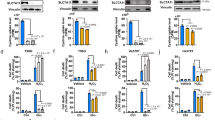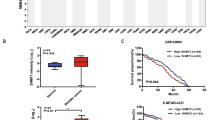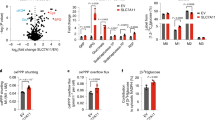Abstract
Sulfiredoxin (Srx) is one of a family of low molecular weight sulfur containing proteins linked with maintenance of cellular redox balance. One function of Srx is the reduction of cysteine sulfinic acid to sulfenic acid in proteins subject to oxidative stress. Other redox active protein families have multiple functions in regulating redox and controlling proliferation/death pathways; increased Srx has been linked with oncogenic transformation. To explore the biological functions of Srx in tumors, we established cell lines that overexpress Srx. Enhanced levels of Srx promoted cell proliferation and enhanced cell death following cisplatin. Srx overexpression triggered an alteration in expression and phosphorylation of cell cycle regulators p21, p27 and p53; stabilized the phosphatase PTEN and, importantly, interacted directly with, and enhanced the activity of, phosphatase PTP1B. In turn, this promoted Src kinase activity by dephosphorylating its inhibitory tyrosine residue (Y530). Srx expression was stimulated by cell exposure to certain growth factors. These data support a role for Srx in controlling the phosphorylation status of key regulatory kinases through effects upon phosphatase activity with an ultimate effect on pathways that influence cell proliferation.
This is a preview of subscription content, access via your institution
Access options
Subscribe to this journal
Receive 50 print issues and online access
$259.00 per year
only $5.18 per issue
Buy this article
- Purchase on Springer Link
- Instant access to full article PDF
Prices may be subject to local taxes which are calculated during checkout






Similar content being viewed by others
References
Adler V, Yin Z, Fuchs SY, Benezra M, Rosario L, Tew KD et al. (1999). Regulation of JNK signaling by GSTp. EMBO J 18: 1321–1334.
Alonso A, Sasin J, Bottini N, Friedberg I, Friedberg I, Osterman A et al. (2004). Protein tyrosine phosphatases in the human genome. Cell 117: 699–711.
Barford D, Flint AJ, Tonks NK . (1994). Crystal structure of human protein tyrosine phosphatase 1B. Science 263: 1397–1404.
Barrett WC, DeGnore JP, Konig S, Fales HM, Keng YF, Zhang ZY et al. (1999). Regulation of PTP1B via glutathionylation of the active site cysteine 215. Biochemistry 38: 6699–6705.
Basu MK, Koonin EV . (2005). Evolution of eukaryotic cysteine sulfinic acid reductase, sulfiredoxin (Srx), from bacterial chromosome partitioning protein ParB. Cell Cycle 4: 947–952.
Biteau B, Labarre J, Toledano MB . (2003). ATP-dependent reduction of cysteine-sulphinic acid by S. cerevisiae sulphiredoxin. Nature 425: 980–984.
Bondareva AA, Capecchi MR, Iverson SV, Li Y, Lopez NI, Lucas O et al. (2007). Effects of thioredoxin reductase-1 deletion on embryogenesis and transcriptome. Free Radic Biol Med 43: 911–923.
Bozonet SM, Findlay VJ, Day AM, Cameron J, Veal EA, Morgan BA . (2005). Oxidation of a eukaryotic 2-Cys peroxiredoxin is a molecular switch controlling the transcriptional response to increasing levels of hydrogen peroxide. J Biol Chem 280: 23319–23327.
Budanov AV, Sablina AA, Feinstein E, Koonin EV, Chumakov PM . (2004). Regeneration of peroxiredoxins by p53-regulated sestrins, homologs of bacterial AhpD. Science 304: 596–600.
Chang TS, Jeong W, Woo HA, Lee SM, Park S, Rhee SG . (2004). Characterization of mammalian sulfiredoxin and its reactivation of hyperoxidized peroxiredoxin through reduction of cysteine sulfinic acid in the active site to cysteine. J Biol Chem 279: 50994–51001.
Chu I, Sun J, Arnaout A, Kahn H, Hanna W, Narod S et al. (2007). p27 phosphorylation by Src regulates inhibition of cyclin E-Cdk2. Cell 128: 281–294.
Czech MP, Lawrence Jr JC, Lynn WS . (1974). Evidence for the involvement of sulfhydryl oxidation in the regulation of fat cell hexose transport by insulin. Proc Natl Acad Sci USA 71: 4173–4177.
Demasi AP, Pereira GA, Netto LE . (2006). Yeast oxidative stress response. Influences of cytosolic thioredoxin peroxidase I and of the mitochondrial functional state. FEBS J 273: 805–816.
Denu JM, Dixon JE . (1998). Protein tyrosine phosphatases: mechanisms of catalysis and regulation. Curr Opin Chem Biol 2: 633–641.
Diet A, Abbas K, Bouton C, Guillon B, Tomasello F, Fourquet S et al. (2007). Regulation of peroxiredoxins by nitric oxide in immunostimulated macrophages. J Biol Chem 282: 36199–36205.
Dube N, Tremblay ML . (2005). Involvement of the small protein tyrosine phosphatases TC PTP and PTP1B in signal transduction and diseases: from diabetes, obesity to cell cycle, and cancer. Biochim Biophys Acta 1754: 108–117.
El-Deiry WS, Tokino T, Velculescu VE, Levy DB, Parsons R, Trent JM et al. (1993). WAF1, a potential mediator of p53 tumor suppression. Cell 75: 817–825.
Findlay VJ, Tapiero H, Townsend DM . (2005). Sulfiredoxin: a potential therapeutic agent? Biomed Pharmacother 59: 374–379.
Findlay VJ, Townsend DM, Morris TE, Fraser JP, He L, Tew KD . (2006). A novel role for human sulfiredoxin in the reversal of glutathionylation. Cancer Res 66: 6800–6806.
Finkel T . (2003). Oxidant signals and oxidative stress. Curr Opin Cell Biol 15: 247–254.
Fruehauf JP, Meyskens Jr FL . (2007). Reactive oxygen species: a breath of life or death? Clin Cancer Res 13: 789–794.
Gallogly MM, Mieyal JJ . (2007). Mechanisms of reversible protein glutathionylation in redox signaling and oxidative stress. Curr Opin Pharmacol 7: 381–391.
Gius D, Spitz DR . (2006). Redox signaling in cancer biology. Antioxid Redox Signal 8: 1249–1252.
Glauser DA, Brun T, Gauthier BR, Schlegel W . (2007). Transcriptional response of pancreatic beta cells to metabolic stimulation: large scale identification of immediate-early and secondary response genes. BMC Mol Biol 8: 54.
Grimmler M, Wang Y, Mund T, Cilensek Z, Keidel EM, Waddell MB et al. (2007). Cdk-inhibitory activity and stability of p27Kip1 are directly regulated by oncogenic tyrosine kinases. Cell 128: 269–280.
Hatahet F, Ruddock LW . (2007). Substrate recognition by the protein disulfide isomerases. FEBS J 274: 5223–5234.
Hirabayashi H . (2002). P27 expression and survival in NSCLC. Nippon Rinsho 60 (Suppl 5): 263–266.
Holmgren A, Johansson C, Berndt C, Lonn ME, Hudemann C, Lillig CH . (2005). Thiol redox control via thioredoxin and glutaredoxin systems. Biochem Soc Trans 33: 1375–1377.
Hunter T . (1995). Protein kinases and phosphatases: the yin and yang of protein phosphorylation and signaling. Cell 80: 225–236.
Jacob C, Holme AL, Fry FH . (2004). The sulfinic acid switch in proteins. Org Biomol Chem 2: 1953–1956.
Jeong W, Park SJ, Chang TS, Lee DY, Rhee SG . (2006). Molecular mechanism of the reduction of cysteine sulfinic acid of peroxiredoxin to cysteine by mammalian sulfiredoxin. J Biol Chem 281: 14400–14407.
Jonsson A, Teixeira PF, Nordlund S . (2008). A novel peroxiredoxin activity is located within the C-terminal end of Rhodospirillum rubrum adenylyltransferase. J Bacteriol 190: 434–437.
Jonsson TJ, Ellis HR, Poole LB . (2007). Cysteine reactivity and thiol-disulfide interchange pathways in AhpF and AhpC of the bacterial alkyl hydroperoxide reductase system. Biochemistry 46: 5709–5721.
Jonsson TJ, Murray MS, Johnson LC, Poole LB, Lowther WT . (2005). Structural basis for the retroreduction of inactivated peroxiredoxins by human sulfiredoxin. Biochemistry 44: 8634–8642.
Kaldis P . (2007). Another piece of the p27Kip1 puzzle. Cell 128: 241–244.
Lee DY, Park SJ, Jeong W, Sung HJ, Oho T, Wu X et al. (2006). Mutagenesis and modeling of the peroxiredoxin (Prx) complex with the NMR structure of ATP-bound human sulfiredoxin implicate aspartate 187 of Prx I as the catalytic residue in ATP hydrolysis. Biochemistry 45: 15301–15309.
Lee DY, Rhee SG, Ferretti J, Gruschus JM . (2005). 1H, 15N, and 13C chemical shift assignments of the human Sulfiredoxin (hSrx). J Biomol NMR 32: 339.
Lei K, Nimnual A, Zong WX, Kennedy NJ, Flavell RA, Thompson CB et al. (2002). The Bax subfamily of Bcl2-related proteins is essential for apoptotic signal transduction by c-Jun NH(2)-terminal kinase. Mol Cell Biol 22: 4929–4942.
Leslie NR, Bennett D, Lindsay YE, Stewart H, Gray A, Downes CP . (2003). Redox regulation of PI 3-kinase signalling via inactivation of PTEN. EMBO J 22: 5501–5510.
Lillig CH, Holmgren A . (2007). Thioredoxin and related molecules--from biology to health and disease. Antioxid Redox Signal 9: 25–47.
Liu XP, Liu XY, Zhang J, Xia ZL, Liu X, Qin HJ et al. (2006). Molecular and functional characterization of sulfiredoxin homologs from higher plants. Cell Res 16: 287–296.
Martinez-Ruiz A, Lamas S . (2007). Signalling by NO-induced protein S-nitrosylation and S-glutathionylation: convergences and divergences. Cardiovasc Res 75: 220–228.
Nakamura H, Nakamura K, Yodoi J . (1997). Redox regulation of cellular activation. Annu Rev Immunol 15: 351–369.
Rey P, Becuwe N, Barrault MB, Rumeau D, Havaux M, Biteau B et al. (2007). The Arabidopsis thaliana sulfiredoxin is a plastidic cysteine-sulfinic acid reductase involved in the photooxidative stress response. Plant J 49: 505–514.
Rhee SG, Jeong W, Chang TS, Woo HA . (2007). Sulfiredoxin, the cysteine sulfinic acid reductase specific to 2-Cys peroxiredoxin: its discovery, mechanism of action, and biological significance. Kidney Int Suppl 106: S3–S8.
Rhee SG, Kang SW, Jeong W, Chang TS, Yang KS, Woo HA . (2005). Intracellular messenger function of hydrogen peroxide and its regulation by peroxiredoxins. Curr Opin Cell Biol 17: 183–189.
Roskoski Jr R . (2005). Src kinase regulation by phosphorylation and dephosphorylation. Biochem Biophys Res Commun 331: 1–14.
Saitoh M, Nishitoh H, Fujii M, Takeda K, Tobiume K, Sawada Y et al. (1998). Mammalian thioredoxin is a direct inhibitor of apoptosis signal-regulating kinase (ASK) 1. EMBO J 17: 2596–2606.
Salmeen A, Andersen JN, Myers MP, Meng TC, Hinks JA, Tonks NJ, Barford D . (2003). Redox regulation of protein tyrosine phosphatase 1β involves a sulphenyl-amide intermediate. Nature 423: 769–773.
Shelton MD, Chock PB, Mieyal JJ . (2005). Glutaredoxin: role in reversible protein s-glutathionylation and regulation of redox signal transduction and protein translocation. Antioxid Redox Signal 7: 348–366.
Singhal S, Vachani A, Antin-Ozerkis D, Kaiser LR, Albelda SM . (2005). Prognostic implications of cell cycle, apoptosis, and angiogenesis biomarkers in non-small cell lung cancer: a review. Clin Cancer Res 11: 3974–3986.
Sun Y, Hegamyer G, Kim H, Sithanandam K, Li H, Watts R et al. (1995). Molecular cloning of mouse tissue inhibitor of metalloproteinases-3 and its promoter. Specific lack of expression in neoplastic JB6 cells may reflect altered gene methylation. J Biol Chem 270: 19312–19319.
Tew KD . (2007). Redox in redux: Emergent roles for glutathione S-transferase P (GSTP) in regulation of cell signaling and S-glutathionylation. Biochem Pharmacol 73: 1257–1269.
Tonks NK . (2006). Protein tyrosine phosphatases: from genes, to function, to disease. Nat Rev Mol Cell Biol 7: 833–846.
Townsend DM, Findlay VJ, Fazilev F, Ogle M, Fraser J, Saavedra JE et al. (2006). A glutathione S-transferase pi-activated prodrug causes kinase activation concurrent with S-glutathionylation of proteins. Mol Pharmacol 69: 501–508.
Townsend DM, He L, Hutchens S, VandenBerg T, Pazoles CP, Tew KD . (2008). NOV-002, a glutathione disulfide mimetic, as a modulator of cellular redox balance. Cancer Res, (In press).
Townsend DM . (2007). S-glutathionylation: indicator of cell stress and regulator of the unfolded protein response. Mol Interv 7: 313–324.
Velu CS, Niture SK, Doneanu CE, Pattabiraman N, Srivenugopal KS . (2007). Human p53 is inhibited by glutathionylation of cysteines present in the proximal DNA-binding domain during oxidative stress. Biochemistry 46: 7765–7780.
Vivancos AP, Castillo EA, Biteau B, Nicot C, Ayte J, Toledano MB et al. (2005). A cysteine-sulfinic acid in peroxiredoxin regulates H2O2sensing by the antioxidant Pap1 pathway. Proc Natl Acad Sci USA 102: 8875–8880.
Wang T, Arifoglu P, Ronai Z, Tew KD . (2001). Glutathione S-transferase P1-1 (GSTP1-1) inhibits c-Jun N-terminal kinase (JNK1) signaling through interaction with the C terminus. J Biol Chem 276: 20999–21003.
Woo HA, Jeong W, Chang TS, Park KJ, Park SJ, Yang JS et al. (2005). Reduction of cysteine sulfinic acid by sulfiredoxin is specific to 2-cys peroxiredoxins. J Biol Chem 280: 3125–3128.
Yeatman TJ . (2004). A renaissance for SRC. Nat Rev Cancer 4: 470–480.
Zhu CQ, Shih W, Ling CH, Tsao MS . (2006). Immunohistochemical markers of prognosis in non-small cell lung cancer: a review and proposal for a multiphase approach to marker evaluation. J Clin Pathol 59: 790–800.
Acknowledgements
We thank Dr Carola A Neumann for providing retroviral vectors and packaging cells. This work was supported by a postdoctoral fellowship grant (T32 CA119945-02) to KL and by CA08660 to KDT. We thank the Drug Metabolism and Pharmacokinetics facility for GSH measurements.
Author information
Authors and Affiliations
Corresponding author
Additional information
Supplementary Information accompanies the paper on the Oncogene website (http://www.nature.com/onc).
Supplementary information
Rights and permissions
About this article
Cite this article
Lei, K., Townsend, D. & Tew, K. Protein cysteine sulfinic acid reductase (sulfiredoxin) as a regulator of cell proliferation and drug response. Oncogene 27, 4877–4887 (2008). https://doi.org/10.1038/onc.2008.132
Received:
Revised:
Accepted:
Published:
Issue Date:
DOI: https://doi.org/10.1038/onc.2008.132



